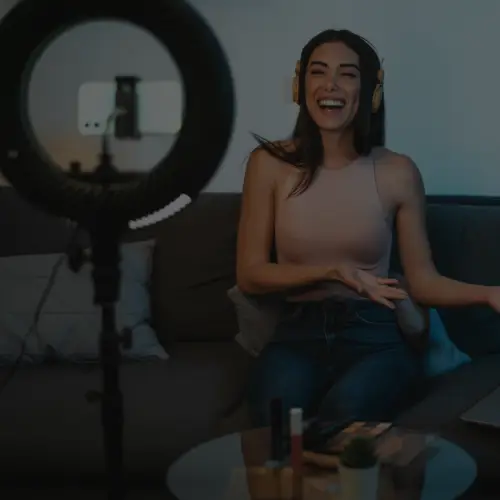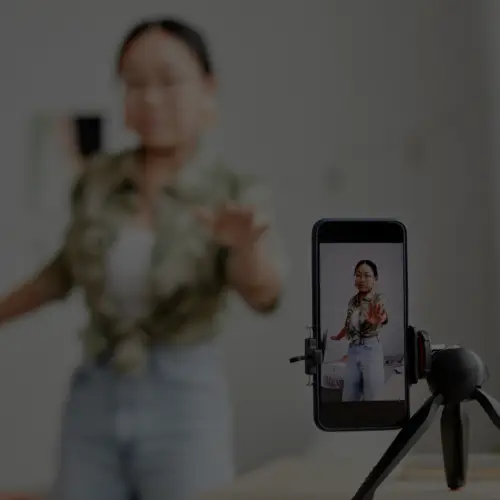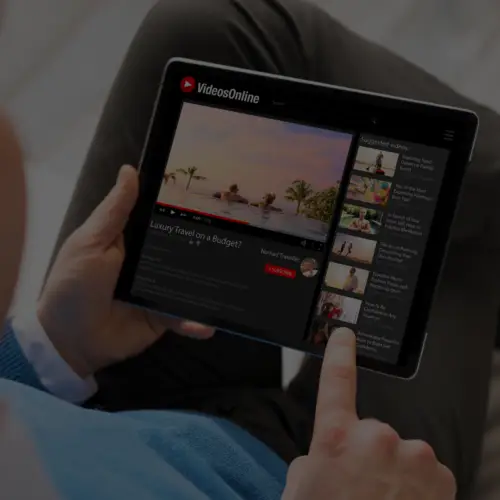
15 Oct An Encyclopedia of Social Media Definitions
The world of social media marketing is constantly evolving, so staying current with trends and terminology is critical for brands and marketers. Social media has a language all its own, and understanding it is crucial to create effective strategies, measure success, and engage audiences authentically.
We’ve put together an encyclopedia of social media jargon to give you the ultimate reference list. Be sure to bookmark this page so you can look back at any time!
Updated for 2025.
Quick Jump Menu
- What is A/B Testing?
- What is Ad Recall?
- What is Ad Scheduling?
- What is Ads Manager?
- What is Advantage+?
- What is Algorithm?
- What is Average Response Time?
- What is B2B Social Media Marketing (Business to Business)?
- What is B2C Social Media Marketing (Business to Consumer)?
- What is Benchmarking?
- What is Boosting?
- What is Brand Advocate?
- What is Brand Awareness?
- What is Business Manager?
- What is Call to Action (CTA)?
- What is Carousel?
- What is Clickbait?
- What is Click-Through Rate (CTR)?
- What is Comment?
- What is Content Calendar?
- What are Conversions?
- What is Conversions API (CAPI)?
- What is Copy?
- What is Cost Per Acquisition (CPA)?
- What is Cost Per Click (CPC)?
- What is Cost Per Engagement (CPE)?
- What is Cost Per Lead (CPL)?
- What is Cost Per Mille (CPM)?
- What is Cost Per View?
- What is Dark Post?
- What is Demographics?
- What is Designated Market Area (DMA)?
- What is Direct Message (DM)?
- What is Dual Placement/Dual Placing?
- What are Dynamic Ads?
- What is Effective Reach?
- What are Engagements?
- What is Engagement Rate?
- What is Evergreen Content?
- What is Exclusive Reach?
- What is Explore Page?
- What is Feed?
- What are Flexible Ads?
- What is For You Page (FYP)?
- What is FTC Compliance?
- What is Gamification?
- What is Geotargeting?
- What is GIF?
- What is Grid?
- What is Hashtag?
- What is Highlights?
- What is Hyperlapse?
- What are Impressions?
- What is Key Performance Indicator (KPI)?
- What is Learning Phase?
- What is Like?
- What is Link in Bio?
- What is Livestream?
- What is Long-Form Video?
- What is Lookalike Audience?
- What is Macro-Influencer?
- What is Marketing Funnel?
- What is Mega-Influencer?
- What is Meme?
- What is Mention?
- What is Micro-Influencer?
- What is Mid-Tier Influencer?
- What is Nano-Influencer?
- What is Native Data?
- What is Natively?
- What is Newsjacking?
- What is Objective?
- What is Organic Post?
- What is Organic Reach?
- What is Paid Post?
- What is Paid Reach?
- What is Permalink?
- What is Pin?
- What is Pinned Comment?
- What is Pinned Post?
- What is Pinterest Board?
- What is Pixel?
- What is Post?
- What is Posting Cadence?
- What is Public API Data?
- What is Reach?
- What are Reactions?
- What is Reactive Community Management?
- What is Reel?
- What is Reply?
- What is Repost?
- What is Repurposed Content?
- What is Retargeting?
- What is Return On Ad Spend (ROAS)?
- What is Retweet?
- What is Save?
- What is Sentiment?
- What is Share?
- What is Short?
- What is Short-Form Video?
- What is Social Commerce?
- What is Social Listening?
- What is Social Voice?
- What is Snapchat Discover?
- What is Spark Ad?
- What is Sponsored Post?
- What is Static Image?
- What is Story?
- What is Subreddit?
- What is Surprise & Delight (S&D)?
- What is Syndicated Content?
- What is Tag?
- What is Target Audience?
- What is Targeting?
- What is Third-Party Targeting?
- What is Thread?
- What is Thumbnail?
- What is Timelapse?
- What is Trendjacking?
- What is Trending Content?
- What is Two Factor Authentication (2FA)?
- What is UGC (User Generated Content)?
- What is Unique Content?
- What is UTM Code?
- What are Video Views?
- What is View Completion Rate (VCR)?
Definitions
General
What is a Hashtag?
Hashtag – Words, phrase, or numbers preceded by the number sign (#) used to categorize, link, and track content. They allow users to discover content on specific topics, participate in trends, boost visibility and reach, and promote campaigns via a specific branded hashtag.
What is an Algorithm?
Algorithm – Platform-dependent, it is a formula used to sort through and prioritize content to determine which posts will appear on a user’s home feed in order to personalize the social media feed based on the user’s online behavior and engagement (likes, shares, saves, etc.).
What is a Nano-Influencer?
Nano-Influencer – a content creator with a small and engaged audience, usually between 1,000 and 10,000 followers, although some count up to 20,000.
What is a Micro-Influencer?
Micro-Influencer – a content creator with a small (but larger than nano) audience who tends to have a more niche following, usually between 20,000 and 100,000 followers.
What is a Mid-Tier Influencer?
Mid-Tier Influencer – a content creator who generally has between 100,000 and 400,000 followers, providing a balance between large-scale awareness and higher engagement.
What is a Macro-Influencer?
Macro-Influencer – a content creator who tends to have a larger reach but lower engagement with their audience, generally between 400,000 and 1,000,000 followers. They usually have more diverse audiences and are able to amplify brand messaging via awareness.
What is a Mega-Influencer?
Mega-Influencer – a content creator (or social media personality) with a massive reach – typically over 1,000,000 followers. These influencers are generally celebrities and may have additional beyond reach, tend to have significant influence over their following due to their celebrity status.
Still curious using influencers? Learn how many a campaign may need.
What is a Sponsored Post?
Sponsored Post – A post from an influencer or creator that a brand pays to be created and promoted, more than likely advertising the brand’s product, services, or messaging. They are designated as an ad by the influencer for transparency.
What is FTC Compliance?
FTC Compliance – Disclosing sponsored content clearly to meet legal requirements of the Federal Trade Commission (in the United States). Many other countries have similar requirements monitored by different government agencies.
What is a Brand Advocate?
Brand Advocate – A user on social media who has become a loyal fan of a brand. An advocate will promote the brand through their own personal social media content via reviews, posts, recommendations, etc. They can be brand customers, employees, or partners/influencers. Generally, content from brand advocates is considered more authentic and trustworthy to consumers.
What is Clickbait?
Clickbait – Ever see those annoying posts where the copy reads, “You’ll never BELIEVE what this woman did…”? That’s clickbait or linkbait. It’s the idea that a brand or publisher uses sensationalized copy to entice the reader into clicking without actually informing them what they’re clicking through to. More often than not, the article it clicks through to isn’t of much value, thereby aggravating people.
What is Trending Content?
Trending Content – Content around a subject, sound, or trend that a huge number of people on social media are talking about within a short timeframe. Typically, trending items are related to current events or celebrities but can also include interactive hashtags like #IWillNeverBeTooOldTo. Trends can last minutes, hours, or days, and they typically have a hashtag or sound associated with them. See how you can strategically use social media trends to boost your brand.
What is Evergreen Content?
Evergreen Content – Content that is valuable and relevant no matter the time of year. It can often be relevant for long periods, even years, as the topics are more permanent than trendy.
What is Newsjacking/Trendjacking?
Newsjacking/Trendjacking – Leveraging current events or viral topics to boost visibility.
What is B2C Social Media Marketing (Business to Consumer)?
B2C Social Media Marketing (Business to Consumer) – When a brand uses social media to market to individual consumers (their target audiences).
What is B2B Social Media Marketing (Business to Business)?
B2B Social Media Marketing (Business to Business) – When a brand uses social media to market to other businesses or companies (their target audience) rather than an individual consumer. These are the platforms we think are best for B2B Marketing.
What is a Marketing Funnel?
Marketing Funnel – The customer journey on social media, usually divided into four stages: awareness (top of funnel), consideration (middle funnel), conversion (lower funnel), loyalty/advocacy (post-purchase). Curious how to measure success at each stage? See how to apply metrics to the marketing funnel here.
What is an Objective?
Objective – A brand’s goal for its social media strategy. Typically, a social media objective may include generating awareness, driving traffic to a website, converting to a sale or lead, or educating. Check out more strategic objectives here.
What is Brand Awareness?
Brand Awareness – A measure of how familiar consumers/customers are with a brand (this may include its logo, products, messaging, etc.).
What is Social Commerce?
Social Commerce – The integration of e-commerce with social media. It allows users to discover and purchase products and services directly on social platforms.
What is a Paid Post?
Paid Post – A piece of content that has money behind it to boost impressions and reach.
What is an Organic Post?
Organic Post – A piece of content that does not have paid amplification behind it. For example, if a brand posts a piece of content to their page and doesn’t put any money behind it, it’s considered organic. This is how brands most commonly posted on Facebook until algorithm changes started making it so only a tiny percentage of fans actually saw branded content. This essentially forced brands to pay for impressions and reach on that channel.
What is a Meme?
Meme – A humorous image that’s shared rapidly, often with copy on it. The copy may change as it’s spread. One thing to note is that it may be tempting for brands to use popular memes, but they can be copyrighted and may set your brand up for legal trouble if used for advertising.
What is a GIF?
GIF – No matter how you pronounce it, a GIF is a short snippet of video that repeats in a loop. People often use them to express emotions in social media, and brands are creating them with their own assets to inspire engagement.
Community Management & Content Production
What is UGC (User Generated Content)?
UGC (User Generated Content) – Content made by your audience (the user, as opposed to a brand or paid influencer), which acts as authentic social proof. Learn when and how you should be using UGC.
What is Surprise & Delight (S&D)?
Surprise & Delight (S&D) – The act of a brand going “above and beyond” to provide unexpected and fun experiences to followers to build brand loyalty and advocacy. These generally include random gifts/swag, exclusive discounts, or unique brand interactions/access.
What is Social Listening?
Social Listening – When someone identifies and assesses what’s being said about a brand, person, product or company on social media. Most brands use real-time listening tools to help with this task. This is a great way to inform upcoming content because you can identify what matters to your audience and form useful, branded content around it.
What is Reactive Community Management?
Reactive Community Management – Engaging with a brand’s community via responding to tagged mentions, responding to comments, and sourcing UGC. See why community management is essential to your brands success.
What is Copy?
Copy – The text located in the caption of the post.
What is a Call to Action (CTA)?
Call to Action (CTA) – This is the action you want your audience to take on a particular piece of content. Some common social media CTAs are encouraging your audience to click a link, share a post, watch a video, or answer a question.
What is Syndicated/Repurposed Content?
Syndicated/Repurposed Content – Duplicated or republished content across multiple platforms
What is Unique Content?
Unique Content – The antonym of “syndicated content;” content that is created specifically for one platform
What is Two Factor Authentication (2FA)?
Two Factor Authentication (2FA) – a method of security that adds an additional layer of protection to your social media accounts, requiring two unique pieces of information (or factors) to prove your identity.
What is a Content Calendar?
Content Calendar – A tool (like an Excel sheet, app, or management platform) that helps brands plan, organize, and schedule posts. The calendar (generally created monthly) usually includes content post details, day and time of publishing, and platforms the content will be posted on, and the status of the pieces. It can be used to help create consistency, streamline the approval process, and allow larger teams to collaborate effectively. Learn how to build a successful content calendar.
What is a Posting Cadence?
Posting Cadence – How often a brand is posting content (whether weekly, monthly, daily, etc.) or your content rhythm. Quality often beats quantity.
What is a Static Image?
Static Image – A non-moving picture (photograph, graphic, infographic, meme, etc.).
What is a Carousel?
Carousel – A post type that shares multiple images, videos, or both in a single post that users can swipe or click through.
What is a Short-Form Video?
Short-Form Video – Video content that is typically less than 2 minutes in length. They have better potential to go viral, are readily consumed/digestible, and are best for brand awareness and engagement.
What is a Long-Form Video?
Long-Form Video – Video content that is typically more than 2 minutes in length. This content format is more commonly used for in-depth storytelling and demonstrations, helping to foster relationships with the consumer.
What is Gamification?
Gamification – Adding an element of game play to online marketing or content. This can be as simple as a brand post where the audience has to answer a trivia question correctly, or as elaborate as a branded app that actually serves as a game.
What is Social Voice?
Social Voice – The overall communication style and personality a brand takes on social media to reflect its brand identity and values.
What is a Target Audience?
Target Audience – A group of people most likely to be interested in your brand, products, or services that share specific characteristics (for example: age, interests, behaviors, location, demographics, etc.).
What are Demographics?
Demographics – Characteristics of an audience, including age/generation, income, education, gender, job, location, ethnicity/race, and marital status.
What is a Thumbnail?
Thumbnail – A smaller image that represents a video or post. The goal is to create an eye-catching, clear thumbnail to encourage users to click and watch or engage with the content.
What is a Timelapse?
Timelapse – A form of video content that showcases a stationary scene over a period of time, sped up. Many use this format to feature content that takes a long time to complete, such as sunsets or how-to demonstrations.
What is a Hyperlapse?
Hyperlapse – A form of video content used on social media that is essentially a moving timelapse. It speeds up the timing of a video, like a timelapse, but isn’t stationary.
What is a Livestream?
Livestream – A form of video or audio content that broadcasts in real-time, allowing the host to interact with viewers in the comments. It is most commonly used for events, Q&As, tutorials, and product launches. It is offered on Instagram, Facebook, X, Twitch, LinkedIn, TikTok, and YouTube.
Paid
What is Dual Placement/Dual Placing?
Dual Placement/Dual Placing – Placing Meta ads to run across both Facebook and Instagram.
What is a Dark Post?
Dark Post – An ad that only appears to targeted users, not on the brand’s profile/grid.
What is Boosting?
Boosting – Promoting an organic post (note: ideally this does not include hitting the “Boost” button on Meta, as this isn’t the most efficient method).
What is Natively?
Natively – Promoting ads or scheduling content through the social networks’ built-in user interface, as opposed to using a third-party tool such as Hootsuite to do so.
What is Ad Scheduling?
Ad Scheduling – Setting specific dates and times for your paid ads to run. This is done to help reach a target audience when they are most active online, thereby increasing your return on investment.
What is Third-Party Targeting?
Third-Party Targeting – Targeting provided by a third-party partner beyond the social networks themselves.
What is a Pixel?
Pixel – An invisible piece of code on a website that tracks how a given computer or user behaves on that site, allowing brands to understand how a user interacts with their website.
What is the Conversions API (CAPI)?
Conversions API (CAPI) – Similar to a pixel; however, it sends data directly from a server (vs. browser). CAPI offers more reliable tracking, especially with the rise of ad blockers and privacy-focused browsers. For a deeper dive, see how to implement Facebook Conversions API.
What is Ads Manager?
Ads Manager – Meta ads platform
What is Advantage+?
Advantage+ – Suite of Meta ad products that leverage AI and automation to optimize ad campaigns for better performance.
What is the Learning Phase?
Learning Phase – A period where the ad delivery system learns about how an ad set may deliver and perform. The system explores the best way to deliver your ads when you create a new ad/set or make a significant edit to an existing one.
What are Dynamic/Flexible Ads?
Dynamic/Flexible Ads – Meta ad format that mixes and matches multiple ad components such as headline, image and call to action into a variety of ad combinations.
What is a Spark Ad?
Spark Ad – A promoted organic TikTok post.
What is a Permalink?
Permalink – Any link within or to a social post; essentially a URL that doesn’t change.
What is Native Data?
Native Data – Refers to social media data pulled directly from the social channel’s built-in reporting infrastructure.
What is Public API Data?
Public API Data – Typically refers to publicly available data through platform APIs (application programming interface) and extracted by third-party tools. These metrics are typically not as comprehensive as what can be extracted from native data, as not all items may be included in APIs.
What is Targeting?
Targeting – The act of picking an audience based on similar attributes, such as demographics (location, age, gender, etc.) and interests.
What is Retargeting?
Retargeting – The process of serving ads across the web to a computer or user who has visited your site before, using the pixel.
What is Geotargeting?
Geotargeting – The practice of delivering different content to different consumers based on his or her geographic location.
What is a Lookalike Audience?
Lookalike Audience – An audience identified by platforms comprised of new potential customers who share similar characteristics with (or look like) a brand’s existing customers (or source audience). This audience is identified in real time using demographics, interests, and behaviors. Using a lookalike audience can help optimize ad spend and boost efficiency.
What is a UTM Code?
UTM Code – A code appended to a URL to allow for advanced tracking of the source, medium, campaign, or ad that drove the visit.
Analytics
What is Average Response Time?
Average Response Time – The average amount of time it takes for a brand to answer a customer’s question or message on social, whether via direct message or comment.
What is Click-Through Rate (CTR)?
Click-Through Rate (CTR) – The percentage of users who clicked after seeing your content.
What is Cost Per Click (CPC)?
Cost Per Click (CPC) – The cost you pay for each click on an ad.
What is Cost Per Engagement (CPE)?
Cost Per Engagement (CPE) – The cost you pay for each engagement on an ad.
What is Cost Per Mille (CPM)?
Cost Per Mille (CPM) – The cost per 1,000 impressions for paid ads.
What is Cost Per View?
Cost Per View – How much each video view costs.
What is Cost Per Acquisition (CPA)?
Cost Per Acquisition (CPA) – The cost of gaining a new paying customer from your campaign.
What is Cost Per Lead (CPL)?
Cost Per Lead (CPL) – The cost of gaining a new prospect, usually one who completes a lead form, from your campaign.
What is an Engagement Rate?
Engagement Rate – Engagements divided by the number of impressions or followers.
What is Reach?
Reach – How many unique users see your content (different from impressions).
What is Effective Reach?
Effective Reach – The percentage of the target audience that is exposed to the advertising schedule a sufficient number of times to produce a positive change in awareness, attitude, purchase action, etc. – based on the concept that exposure below the effective frequency has little or no value.
What is Exclusive Reach?
Exclusive Reach – Number of different persons who are exposed to one media vehicle in combination, and not any other vehicles.
What is Organic Reach?
Organic Reach – The number of people who saw the organic version of the post at least once without paid support.
What is Paid Reach?
Paid Reach – The number of people who saw the promoted version of the post at least once.
What are Impressions?
Impressions – The number of times your content appears on screens.
What are Engagements?
Engagements – The number of likes, comments, shares, saves, and interactions.
What are Conversions?
Conversions – A desired action of the brand that a user takes on social media that contributes to the brand’s overarching objectives. Examples include buying a product or service, signing up for an e-newsletter, downloading a resource, registering for a webinar, downloading an app, visiting a website, etc. Want to know more about Conversions? Read on.
What is Sentiment?
Sentiment – The measurement of content based on whether that content is positive, negative or neutral in terms of a brand or topic.
What are Video Views?
Video Views – Platforms define this differently: TikTok counts auto-plays, Meta requires 3 seconds, and YouTube requires 30 seconds.
What is View Completion Rate (VCR)?
View Completion Rate (VCR) – The frequency of people watching the whole video out of everyone who watched any part of the video. Calculated by dividing the number of video completions by the total number of video views.
What is Return On Ad Spend (ROAS)?
Return On Ad Spend (ROAS) – A measurement of ad spend efficiency usually calculated by value (e.g., purchases, scheduled events) divided by ad spend.
What is Ad Recall?
Ad Recall – Research technique used to measure the respondent’s ability to remember elements of an advertisement, typically 48 hours after seeing the ad.
What is a Designated Market Area (DMA)?
Designated Market Area (DMA) – A geographic area that represents specific television markets as defined by and updated annually by the Nielsen Company. According to Nielsen, “a DMA region is a group of counties that form an exclusive geographic area in which the home market television stations hold a dominance of total hours viewed.”
What is a Key Performance Indicator (KPI)?
Key Performance Indicator (KPI) – The most important metrics that define the success of your social media marketing efforts. Read more about KPIs and other valuable terms here.
What is Benchmarking?
Benchmarking – Setting baselines to measure campaign success.
What is A/B Testing?
A/B Testing – A test that compares minor variations of a piece of content (post, ad, etc.) to see which one performs better and better drives the brand’s objectives, improving content effectiveness.
Platform-Specific
What is a Post?
Post – A piece of content published on a social media platform. Post types include text, single image, carousel, video, links, and audio.
What is a Reel?
Reel – A short-form, vertical piece of video content on Instagram or Facebook (similar to a video on TikTok).
What is a Story?
Story – Ephemeral content (disappearing after 24 hours) consisting of photos and/or videos, often utilizing text overlays and interactive elements like polls, stickers, etc. This content tends to be more digestible to consumers and more in-the-moment. They are often displayed at the top of a user’s feed.
What is a Short?
Short – A short-form, vertical piece of video content on YouTube, like a Reel on Meta.
What is a Pin?
Pin – Pinterest’s form of a “post.” It can be an image or video that users can save to their own boards.
What is a Pinterest Board?
Pinterest Board – A curated collection on the platform where users can save, organize, and categorize Pins (usually for a specific theme, project, or purpose). Boards can be private or public, and users can opt to make them shared (a Board that multiple users can contribute to).
What is a Subreddit?
Subreddit – A community on Reddit that is dedicated to a specific subject (ranging from broad to niche topics) that users can post and comment under. Subreddits have their own rules and moderators. They are denoted by the prefix /r/ (example: /r/travel).
What is a Thread?
Thread – A series of connected posts where the first post acts as the beginning of a conversation or story and the subsequent replies tell the rest of the story. The goal is to make it easier to follow along for when stories can’t be told in a single post. These are most commonly seen on X, but also on Instagram, Reddit, Instagram’s Threads, and Facebook.
What is a Direct Message (DM)?
Direct Message (DM) – A private conversation between two or more users on a platform. It can be used as a noun or verb.
What is a Like?
Like – A type of engagement on platforms to show that a user approves, enjoys, or agrees with a post. It differs depending on platform: a like is a thumbs-up on Facebook, the word “Like” on LinkedIn, and a heart on Instagram and X.
What is a Mention?
Mention – A reference to a brand on social media via content (text, image, or video). Usually, this includes going beyond a verbal mention and also tagging the brand in content.
What is a Tag?
Tag – A reference to a brand on social media by using the @ symbol followed by the brand’s account. It notifies the tagged user and allows them to share that content on their own profile. Tags can be included in comments, text posts, or image/video content. A tag can also refer to a label that categorizes content to make it searchable.
What is a Repost?
Repost – To reshare another user’s social media content to your own profile, page, or feed. When reposting content, you should provide credit to the original creator.
What is a Retweet?
Retweet – Native to X, to reshare another user’s post on social media to your own feed. You can either retweet a post as is or add your own thoughts to it (known as a Quote Tweet).
What are Reactions?
Reactions – Most commonly used on Facebook and LinkedIn, a type of quick engagement on a social media post often expressed as emojis. Reactions include “Like”, “Love”, “Wow”, “Angry”, “Sad”, “Haha”, “Celebrate”, and “Support”.
What is a Comment?
Comment – A response or reply by a user on a social media post. It can be in the form of text, emojis, gifs, images, mentions, etc. Comments are considered a deeper level of engagement than a reaction.
What is a Pinned Comment?
Pinned Comment – A comment that the profile user purposefully chooses to keep at the top of the comment section. It keeps it more visible to other users.
What is a Pinned Post?
Pinned Post – A post that the profile user purposefully chooses to keep at the top of their feed/grid to increase visibility.
What is a Reply?
Reply – A response to another user’s comment or post.
What is a Share?
Share – The act of reposting or redistributing content from one user to another. This can be done publicly (like through a repost) or privately (like through a direct message).
What is a Save?
Save – The act of bookmarking content to view later.
What is the Explore Page?
Explore Page – A personalized feed of content from accounts the user does not follow that is curated by the platform’s algorithm that analyzes the user’s behavior on the app. The Explore page is native to Instagram.
What is the For You Page (FYP)?
For You Page (FYP) – TikTok’s version of the Explore Page that gives personalized content a user is likely to enjoy.
What is Snapchat Discover?
Snapchat Discover – A part of the app that features curated, mobile-first content from brands, creators, media outlets, etc., in a story-like format. The content is presented as “collections” made up of different snaps and videos. This content is also personalized based on the user’s interests and behavior on the app.
What is Business Manager?
Business Manager – Meta’s free tool for managing Facebook and Instagram advertising assets and permissions.
What is a Feed?
Feed – The stream of content on platforms that continuously updates from accounts the user follows, ads, and recommended content (that the platform’s algorithm sees fit for the user). Feeds tend to be ordered chronologically or algorithmically.
What is a Grid?
Grid – The layout of a user’s profile page. This term is most commonly used for Instagram where content is displayed in a series of rows and columns.
What are Highlights?
Highlights – A collection of past Stories that users can save to their profiles, making them permanent vs ephemeral. Highlights are most prevalent on Instagram, but they are also available on Facebook.
What is Link in Bio?
Link in Bio – A clickable URL in a social media profile’s bio section used to drive traffic to an external website. For Instagram, it is the only place a user can include a direct link on an organic post.
Hopefully this guide can serve as a great reference next time brain fog hits and you blank on a word – it happens to the best of us!
Now that you speak the language of social, let’s put it to work. Fill out the form below and let’s chat about growing your brand.






